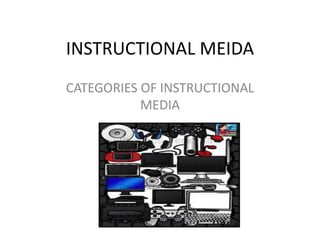Instructional meida.pptx categories
•Download as PPTX, PDF•
1 like•248 views
instructional media categories
Report
Share
Report
Share

Recommended
Instructional media and technology in teaching communication arts

Instructional media and technology in teaching communication artsDepartment of Education - Philippines
Recommended
Instructional media and technology in teaching communication arts

Instructional media and technology in teaching communication artsDepartment of Education - Philippines
More Related Content
What's hot
What's hot (17)
Educational Media & Technology in 2013: What’s Next? 

Educational Media & Technology in 2013: What’s Next?
Factors to-be-considered-in-selecting-instructional-media

Factors to-be-considered-in-selecting-instructional-media
Preparation and evaluation of instructional materials

Preparation and evaluation of instructional materials
Similar to Instructional meida.pptx categories
Similar to Instructional meida.pptx categories (20)
EDUCATION MEDIA ND TECHNOLOGY in postgraduate.pptx

EDUCATION MEDIA ND TECHNOLOGY in postgraduate.pptx
People Media ( Media and Information Literacy for Grade 11)

People Media ( Media and Information Literacy for Grade 11)
Mass communication and literacy & education development

Mass communication and literacy & education development
IMPACT OF TECHNOLOGY AND MEDIA ON SCHOOL AND CULTURE

IMPACT OF TECHNOLOGY AND MEDIA ON SCHOOL AND CULTURE
Recently uploaded
Recently uploaded (20)
Benefits and Challenges of Using Open Educational Resources

Benefits and Challenges of Using Open Educational Resources
Forest and Wildlife Resources Class 10 Free Study Material PDF

Forest and Wildlife Resources Class 10 Free Study Material PDF
INU_CAPSTONEDESIGN_비밀번호486_업로드용 발표자료.pdf

INU_CAPSTONEDESIGN_비밀번호486_업로드용 발표자료.pdf
Students, digital devices and success - Andreas Schleicher - 27 May 2024..pptx

Students, digital devices and success - Andreas Schleicher - 27 May 2024..pptx
slides CapTechTalks Webinar May 2024 Alexander Perry.pptx

slides CapTechTalks Webinar May 2024 Alexander Perry.pptx
Matatag-Curriculum and the 21st Century Skills Presentation.pptx

Matatag-Curriculum and the 21st Century Skills Presentation.pptx
aaaaaaaaaaaaaaaaaaaaaaaaaaaaaaaaaaaaaaaaaaaaaaaaaaaaaaa

aaaaaaaaaaaaaaaaaaaaaaaaaaaaaaaaaaaaaaaaaaaaaaaaaaaaaaa
Instructions for Submissions thorugh G- Classroom.pptx

Instructions for Submissions thorugh G- Classroom.pptx
The Art Pastor's Guide to Sabbath | Steve Thomason

The Art Pastor's Guide to Sabbath | Steve Thomason
Adversarial Attention Modeling for Multi-dimensional Emotion Regression.pdf

Adversarial Attention Modeling for Multi-dimensional Emotion Regression.pdf
Salient features of Environment protection Act 1986.pptx

Salient features of Environment protection Act 1986.pptx
Basic phrases for greeting and assisting costumers

Basic phrases for greeting and assisting costumers
Instructional meida.pptx categories
- 1. INSTRUCTIONAL MEIDA CATEGORIES OF INSTRUCTIONAL MEDIA
- 3. TEXT MEDIA • Text media consists of alphanumeric letter and characters either printed on papers, books, or projected from a computer screen. It is the most commonly used media in most classrooms today.
- 4. Types of text media •Printed Books, brochures, newspapers, manuals •Displayed Bulletin boards, flipcharts •Projected Texts projected by LCD or overhead projectors •Digital E-books, E-zines, E-journal
- 6. AUDIO MEDIA Audio media refers to the various means that can make human voice and other sounds into more powerful forms of information, communication, and education. Its type ranges from • the traditional vinyl records • cassette tapes to digital ones like compact discs and • portable media players. The use of audio media can stimulate students learning and may serve as motivation for them. From the content areas like Math and Science to the musically inclined subjects, audio media has a great application.
- 8. VISUAL MEDIA Most of us are visual people. We learn and remember things through pictures or images. Visual media has a great contribution to our learning. Our mind processes messages as images rather than as audio or texts. A person should be visually literate in order to critically evaluate, examine and efficiently use various visual representations around him. A visually literate person finds and accesses needed images efficiently. He can also evaluate the appropriateness and reliability of the image before using it. Furthermore, he can also make and create his own visual designs.
- 10. MOTION MEDIA • As the name connotes, it is MEDIA IN MOTION. It combines motion, color, and sound in ways that can show ideas better than any other medium. Videos are example of this kind of media. Advantages of using motion media in the classroom are as follows: • 1. Motion is the best media in portraying concepts that include motion. (E.g. The division of cells) • 2. Steps and procedures can be shown more effectively. • 3. It provides risk-free observation. Phenomena that might be dangerous when view directly, like volcanic eruption, can be shown in videos without causing any hazardous effect. • 4. It can also bring affective impact to students
- 12. PEOPLE MEDIA • This media has two types: People as media and People in media. The former is the use of people as a medium by utilizing the people themselves to transfer information while the latter pertains to the people working in mass media. Examples of people as media are teachers, students, administration, resource s peakers, etc. • People in media include the editorial board, tv and radio people etc.
- 14. MANIPULATIVE MEDIA • physical objects that are used as teaching tools to engage students in the hands-on learning of different subjects. (such as markers, toothpicks, or coins) provide visible models that help students solve problems and develop concepts. • Enables students to explore concepts at the first, or concrete level of understanding. • Using concrete manipulative is the first step to using mental images and models. • Students can easily remember the lesson through images by the use if manipulatives.